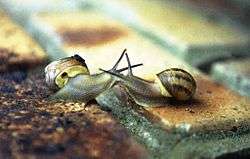Pasilalinic-sympathetic compass

The pasilalinic-sympathetic compass, also referred to as the snail telegraph, was a contraption built to test the pseudo-scientific hypothesis that snails create a permanent telepathic link when they mate. The device was developed by French occultist Jacques Toussaint Benoit, with the supposed assistance of an American colleague, Monsieur Biat-Chretien[1][Notes 1] in the 1850s.
The hypothesis
Benoit claimed that when snails mate[2] a special type of fluid forms a permanent telepathic link between them. This fluid forms an invisible thread that keeps the snails in "sympathetic communication" by using animal magnetism similar to an electric current pulsating along it.[3] They claimed that this method would work instantly, wirelessly, over any distance, and be more reliable than a telegraph.[3][4]
This was not the first attempt to create a form of sympathetic communication. There are stories of people cutting pieces of the flesh of their arms off and trading it with another person, tatooing the alphabet on each arm, and pricking the letters they wished to communicate to the person from whose arm the flesh had been taken, and it was upon this principle that Benoit built his theory.[5][4] William Brooke O'Shaughnessy is one prominent telegrapher who experimented with using human skin to send and receive messages.[4]
The apparatus
Benoit did not have enough financial capital to build his design. Benoit persuaded Monsieur Triat, manager of a Paris gymnasium, to give him lodgings and an allowance, having impressed upon him the importance of his discovery. After a year Triat's patience grew thin and he demanded to see a working model.[3][6]
The apparatus consisted of a scaffold of 10 foot long wooden beams supporting zinc bowls[4] lined with a cloth soaked in a copper sulphate solution; the cloth was held in place by a line of copper. At the bottom of each of the 24 basins was a snail, glued in place, and each associated with a different letter of the alphabet. An identical second device held the paired snails.[3] To transmit a letter the operator touched one of the snails. This was supposed to cause a reaction in the corresponding snail which could then be read by the receiving operator.[3]
Demonstration
On 2 October 1851 Benoit invited Triat and friend Jules Allix, a journalist from La Presse. He first asked Triat and then Allix to stand at one station and to spell out a word - he would then tell them what the word was by reading from the receiving end.[3] However, the transmission was inaccurate, with him supposedly receiving errors such as “gymoate” instead of “gymnase”,[4] and he continually walked between the two devices,[3] claiming it was necessary to supervise his assistants to ensure they were touching and reading the snails correctly.[2] Triat began to suspect that it was a hoax.[3] Allix, however, was convinced by the demonstration and he wrote an article full of praise for Benoit's creation which appeared in the newspaper on 27 October 1851.[3][4] Among other praise, Allix suggested that ladies might wear the device on their "wasit-chains."[4] Triat demanded a second, stricter test to which Benoit agreed. When the time came though Benoit had vanished.[3] He was subsequently seen wandering the streets of Paris, and died within two years.[3]
Influence
During the 1871 uprising in the Paris Commune, the need to send and receive secured messages prompted a revival of the idea by Marquis Rochefort, president of the barricades commission.[4][7] However, it proved to be as unreliable then as it had originally been.[4]
The device also provided inspiration for the Japanese manga series One Piece,[4] which includes Transponder Snails that can be attached to electronic equipment and function as telephones,[8] fax machines,[8] and surveillance cameras.[9] Along with the Allix article in La Presse the story of the pasilalinic-sympathetic compass was covered by the 1889 book Historic Oddities and Strange Events by Sabine Baring-Gould.[6]
References
Explanatory notes
- ↑ According to Dickens, no one ever saw Monsieur Biat, and it is undetermined if he really existed.
Citations
- ↑ Dickens, Charles (1890). All the Year Round. pp. 179–180. Retrieved 9 August 2016.
- 1 2 Brownlee, John (27 November 2006). "The Snail Telegraph of Jacques Benoit". Wired. Retrieved 9 August 2016.
- 1 2 3 4 5 6 7 8 9 10 11 Howard, Toby. 1995. "Progress at snail's pace". Accessed 28 May 2007.
- 1 2 3 4 5 6 7 8 9 10 Rosen, Rachel. "Psychic Snail Sex Couldn't Replace the Telegraph, But One Frenchman Sure Tried". Atlas Obscura. Retrieved 9 August 2016.
- ↑ Fahie, John Joseph (1884). A History of Electric Telegraphy, to the Year 1837. E. & F. N. Spon. pp. 19–20. Retrieved 9 August 2016.
- 1 2 2004. "The Snail Telegraph". Accessed 28 May 2007.
- ↑ J., E. H. (1905). "Recollections of a Visit to Sir Edward Bulwer Lytton at Knebworth in 1857". Blackwood's Edinburgh Magazine (177). Retrieved 9 August 2016.
- 1 2 Oda, Eiichiro (December 1999). "二人目". 東一番の悪. One Piece (in Japanese). 11. Shueisha. pp. 74–75. ISBN 4-08-872797-5.
- ↑ Oda, Eiichiro (June 2009). もう誰にも止められない. One Piece (in Japanese). 54. Shueisha. ISBN 978-4-08-874662-3.